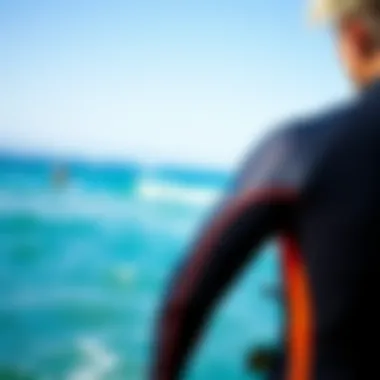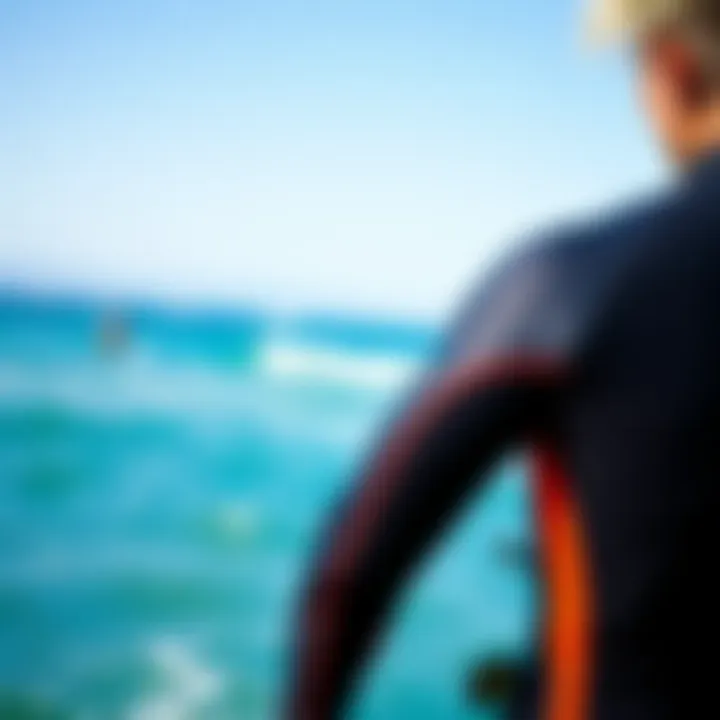Wetsuit vs Drysuit: Choosing the Best for Kiteboarding


Intro
Water sports often draw enthusiasts to the thrilling embrace of the ocean, lakes, or rivers, and for those who wish to push their limits, understanding the gear is essential. Among the key pieces of equipment for water activities are wetsuits and drysuits. Each suit serves a unique purpose and is engineered to respond to different environmental conditions, making them vital for kiteboarding and other water sports. This article delves into the differences between these two suits, examining their construction, functionality, and how they apply to various water scenarios. As we embark on this exploration, our goal is to equip readers with the knowledge needed to make informed decisions about their gear based on temperature, activity, and personal preferences.
Gear Insights
Latest Gear Reviews
When it comes to wetsuits and drysuits, the market has plenty of options to navigate. The material and design can vary widely across brands, each making claims about performance and comfort. For example:
- O'Neill Psycho Tech Wetsuit: Known for its 3D pre-shaped fit, this suit is a favorite among cold-water kiteboarders, offering exceptional flexibility and warmth.
- Mister Dry Drysuit: A solid pick for those looking to stay dry in frigid water, this suit's lightweight construction and breathable fabric make it a top choice for durability and performance.
Reading reviews from users, especially on platforms like Reddit and specialized gear forums, can provide insight into the real-world performance of these suits.
Essential Gear for Beginners
If you're just starting out in kiteboarding, choosing the right suit is crucial. Here’s what beginners should consider:
- Material: Neoprene is the standard for wetsuits, providing insulation and comfort. Drysuits often feature breathable fabrics that keep you dry, but they can be pricier.
- Fit: A snug fit is essential for both types of suits; they should feel like a second skin.
- Thickness: For wetsuits, choose thickness based on local water temperatures. A 3/2 mm suit might work for spring and summer, while a 5/4 mm design is better for colder climates.
In addition, for drysuits, look for sealed seams and adjustable cuffs that help minimize water entry.
"Wetsuits are great for a bit of cold, but if the water is icy, a drysuit is your best friend. Don't skimp on gear if you are serious about the sport."
- An experienced kiteboarder from a community forum.
As you embark on your kiteboarding journey, ensuring you have the right gear can significantly enhance your experience, allowing you to focus on mastering the waves instead of worrying about the chilly embrace of the water.
Intro to Wetsuits and Drysuits
When it comes to water sports, particularly activities like kiteboarding, having the right gear can make all the difference between a thrilling adventure and a chilling memory. Understanding the distinction between wetsuits and drysuits is crucial for anyone stepping into the water. Each type of suit serves a specific purpose, catering to different conditions and individual preferences. In this article, we will dive into the intricacies surrounding these two types of suits, examining how they function and what makes each of them uniquely suited to various water sports.
Wetsuits, designed to keep the wearer warm by trapping a thin layer of water between the skin and the suit, allow for flexibility and mobility. They're often made from a thick neoprene material that insulates and protects against the chills of cold water. Ideal for milder conditions, wetsuits are popular among surfers, divers, and kiteboarders alike. However, what happens when temperatures drop even further? That's where drysuits come into play.
Drysuits, as the name suggests, are crafted to keep the wearer completely dry. They feature sealed seams and a watertight closure that ensures no water gets in. This makes them perfect for extreme conditions, whether you are racing the wind or sailing through icy waters. Understanding when to choose a wetsuit over a drysuit, or vice versa, is essential for maximizing both safety and enjoyment.
Key Benefits of Understanding Wetsuits and Drysuits
- Optimal Performance: Selecting the right suit can significantly enhance your overall performance on the water.
- Comfort Level: Knowing how each suit functions allows you to determine which offers the most comfort based on the environment you’ll face.
- Safety Precautions: Awareness of temperature control can prevent potential injuries associated with water exposure or hypothermia.
- Long-Term Investment: Understanding the differences aids in making an informed purchase, ensuring your gear lasts longer and meets your needs.
In addition to these benefits, considerations such as body type, activity level, and climate also play a role when choosing between a wetsuit and a drysuit. The right information can aid in making choices that enhance not just your experience but also your confidence on the water. After all, being informed is half the battle when you're faced with the waves, wind, and open water.
"The sea is a dangerous place without the proper gear; understanding the tools at your disposal mitigates that danger and enhances your adventure."
Thus, gear up as we explore the nuances of these essential water sports garments, providing kiteboarders, instructors, and adventurous souls with the knowledge they need to thrive in the aquatic realm.
The Basics of Wetsuits
Wetsuits play a crucial role in water sports, especially when it comes to activities like kiteboarding. They serve not only as a barrier against cold waters but also contribute to buoyancy, allowing adventurers to stay comfortable during their pursuits. In understanding the basic elements of wetsuits, it becomes clearer how they function and what makes them a vital piece of gear for enthusiasts.
Definition and Purpose
A wetsuit is a specialized garment made primarily of neoprene, designed to be worn by individuals engaging in water activities. Its main purpose is to insulate the body by trapping a thin layer of water between the suit and the skin. As the body warms this layer, it helps maintain core temperature, critical in combating the chill of open waters. For kiteboarders, this means they can enjoy longer sessions without succumbing to the shivering cold that can detract from the experience.
Materials Used in Wetsuits


Wetsuits are primarily made from neoprene, a synthetic rubber that is both flexible and insulating. There are different grades of neoprene, and the thickness varies, typically ranging from 2mm to 7mm. Thicker materials provide more warmth, while thinner ones allow for greater freedom of movement.
- Smooth Skin Neoprene: Often featured in the outer layers, this material is slick and reduces wind resistance.
- Jersey Neoprene: Usually found on the inside, it adds comfort against the skin and is often easier to put on and take off.
The combination of these materials crafts a suit that balances warmth, comfort, and functionality, making it essential for activities like kiteboarding.
Types of Wetsuits
Different types of wetsuits cater to various conditions and preferences. Understanding these options can greatly influence a kiteboarder’s performance and enjoyment.
Full Wetsuits
Full wetsuits cover the entire body, including arms and legs. The primary advantage of a full wetsuit is its ability to provide maximum warmth in colder waters. This configuration is ideal for kiteboarding in cooler climates, as it helps to retain heat and protect against wind chill. As an additional benefit, it offers ample coverage, reducing the risk of abrasions during intense riding sessions. However, one downside is that full wetsuits can feel restrictive at times, limiting mobility for some riders who prioritize flexibility.
Shorty Wetsuits
Shorty wetsuits are distinct for their short sleeves and legs, making them better suited for warmer water conditions. They are lighter and less constricting, offering greater range of motion than full suits. This type is favored in transitional seasons or milder climates, where the water isn't too chilly. Although shorty wetsuits provide less thermal protection than full suits, they shine in warm waters where freedom of movement is key, allowing kiteboarders to focus on their tricks without feeling bogged down.
Spring Suits
Spring suits boast sleeves that extend to the elbows but have short legs. They blend the characteristics of full and shorty wetsuits, making them a versatile option. Their unique feature is a blend of coverage and mobility, making them suitable for those spring days when the water is still cool, but air temperatures are rising. Spring suits offer a middle ground; however, they might not provide enough warmth in truly frigid conditions, requiring riders to consider the specific weather and water temperatures before deciding on this option.
Overall, selecting the right type of wetsuit can significantly enhance the kiteboarding experience, offering tailored protection against the elements while ensuring optimal comfort and flexibility.
The Drysuit Explained
Understanding the drysuit is crucial for water sports enthusiasts, especially those venturing into colder waters like kiteboarding. The drysuit serves not merely as another piece of gear but as a vital piece of equipment that ensures comfort and safety in challenging conditions. By keeping the body dry, it allows the user to maintain optimal body temperature and prolongs the time spent in often frigid environments. When optimal performance and survivability in the water comes into play, your suit choice can significantly influence your overall experience.
Definition and Functionality
A drysuit is designed to keep the wearer completely dry by featuring sealed seams and waterproof zippers. Unlike wetsuits, which allow a thin layer of water to enter and keep the body warm through insulation, drysuits create a barrier between the body and the water. This is essential for activities performed in chilly temperatures, where hypothermia can be a serious risk. By using a drysuit, adventurers benefit from being able to add thermal layers underneath the suit, effectively customizing their insulation based on current conditions.
Drysuit Materials and Construction
Most drysuits are composed of specialized, breathable materials that offer both durability and flexibility. Neoprene and nylon are common, but many suits incorporate high-tech fabrics like Gore-Tex or other waterproof fabrics, combining comfort with performance. These materials not only ensure that water stays out but also allow moisture from perspiration to escape, creating a balance between warmth and breathability. Furthermore, the zippers are engineered to endure the rigors of water activity while maintaining a watertight seal, ensuring that the drysuit functions as intended.
Types of Drysuits
When selecting a drysuit, it’s important to consider different styles and designs that suit various needs.
Rear-Zip Drysuits
Rear-zip drysuits feature a zip closure located at the back, making them a favorite among many water sports enthusiasts. The obvious advantage here is that it often provides a snug fit around the torso and is less likely to snag during activity. Their streamlined design enhances movement, making this type of suit popular, especially for kiteboarders who need maximum mobility. However, putting on a rear-zip drysuit can be a bit of a juggling act, requiring assistance or some clever maneuvering to get into.
Front-Zip Drysuits
Front-zip drysuits, as the name suggests, have the zipper located at the front, meaning they’re usually easier to put on by oneself. This functionality can be a significant benefit, especially when you’re gearing up in a brisk open environment. They often allow for more airflow, which can be a plus when temperatures start to rise. However, depending on the design, they might not provide the same level of thermal efficiency as rear-zips. This trade-off has led many to choose based on personal preference, comfort, and specific use cases.
"Choosing the right drysuit can make all the difference between an enjoyable day on the water and a very uncomfortable one."
The insights gathered from the capabilities and materials of drysuits shed light on their importance in various conditions. Armed with this understanding, kiteboarders and extreme sports enthusiasts can make educated decisions, ensuring their equipment enhances rather than hinders their experience.
Key Differences Between Wetsuits and Drysuits
Wetsuits and drysuits serve crucial, yet distinct, roles in the world of water sports. Understanding their key differences can be a game-changer for anyone wanting to make the most out of their time on the water. Whether you're a kiteboarder, a surfer, or just someone who enjoys the splashes of open water, knowing what each suit brings to the table and when to use them can dramatically enhance your experience.
The importance of thermal management, water resistance, and comfort in water sports cannot be overstated. Wetsuits and drysuits each provide unique advantages based on the conditions you're likely to face. One may keep you warm when the sun is barely peeking through the clouds, while the other ensures you stay dry even in frigid waters. This section examines these critical differences in detail to help you make an informed choice for your next aquatic adventure.


Temperature Regulation
Both wetsuits and drysuits are designed with temperature control in mind, but they achieve this in drastically different ways.
Wetsuits are intended to trap a thin layer of water between the suit and your skin. As your body heats this layer, it provides insulation, keeping you relatively warm even in cooler conditions. However, as water temperatures drop, this system can become ineffective, especially if the suit is too thin for the temperatures you're facing.
On the other hand, drysuits are built to keep all water out, featuring watertight seals at the neck, wrists, and ankles. This design means you can wear insulation layers underneath, allowing for greater customization in cold conditions. By layering your clothing, you ensure that you can adapt to a range of temperatures without compromising on warmth. It’s important to consider the expected water temperature when deciding between the two — if you think you might be facing frigid conditions, a drysuit might be your best bet.
Water Resistance and Insulation
When we talk about water resistance, here’s where the rubber meets the road, quite literally. Wetsuits, while providing some level of insulation, allow water to seep in, which means that, after prolonged exposure, you will eventually feel the chill. They can work quite well in warmer waters but might leave you shivering in cooler settings. The thicker the suit, the better your insulation, but that can also impact your flexibility.
Conversely, drysuits truly shine in terms of keeping moisture at bay. If you're engaged in activities that frequently lead to immersion or involve colder weather, a drysuit acts as a shield. Select models come with integrated insulation and specialized materials designed to fend off the icy grip of cold water. The trade-off here, however, is often decreased mobility compared to wetsuits. If you're performing actions that require agility, it can be a balancing act between insulation and flexibility.
Breathability and Comfort
Breathability is an understated yet critical factor when choosing between a wetsuit or drysuit. Wetsuits are generally more breathable compared to drysuits, allowing you to sweat while remaining mobile.
However, drysuits can be more comfortable in cooler conditions since you can control what layers you wear beneath. Just think about it: if you're zipping around in the water for hours, having a comfortable base layer underneath can keep you focused and enjoying the ride, rather than battling discomfort. A good fit in a drysuit can also prevent the uncomfortable tightening that can occur as you move, which is a common concern for surfers and kiteboarders alike.
A reminder for those who wear drysuits: always check your seals before heading out! These little components can make or break your experience.
Suitability for Kiteboarding
Kiteboarding is a thrilling water sport that combines elements of surfing, sailing, and extreme sports. As exciting as it is, the choice between a wetsuit and a drysuit can significantly affect performance and comfort in varying weather conditions. This section explores the suitability of both types of suits for kiteboarding, focusing on specific elements crucial for an optimal riding experience.
Wetsuits in Kiteboarding Conditions
Wetsuits make up a staple of many kiteboarders' gear, especially in warmer conditions or when participating in activities like kite surfing. They are designed to keep the body warm by trapping a thin layer of water against the skin, which then warms up with body heat. When kiteboarding in moderate temperatures, a suit like a shorty or full wetsuit can provide the necessary insulation along with flexibility for movement.
The construction material of wetsuits, mainly neoprene, plays a vital role in their insulation capabilities. For instance, a thicker wetsuit—such as one made of 3/2mm neoprene—provides better thermal protection for cooler days while still allowing excellent mobility. Think of it this way: having a snug wetsuit is like having a warm hug while you zip through the waves.
However, when the temperature starts rising, a shorty wetsuit might be more appropriate, offering coverage yet keeping you from overheating.
Drysuits for Cold Water Kiteboarding
In contrast, if you're planning to hit the chilly waters, whether it be during early spring or late fall, drysuits are the go-to option. These suits are typically crafted from waterproof and breathable materials, allowing the kiteboarder to stay completely dry inside while cutting down the wind chill drastically. As the name suggests, a drysuit keeps water out, which is essential for preventing hypothermia in frigid conditions.
The ability to layer underneath a drysuit is another advantage. You can adapt your thermal wear based on the temperature, ranging from light base layers to thicker insulation as needed. This level of versatility is significant for kiteboarders who often find themselves in rapidly changing environments. Besides, you won’t have to deal with the discomfort of water seeping in, as can happen with wetsuits.
Comparative Performance in Extreme Conditions
When it comes to extreme weather and water conditions, both suits offer distinct advantages and disadvantages. For instance, during a chilly winter session when temperatures dip below 50F, a drysuit can be a lifeline, preserving body heat effectively. In such cases, kiteboarders are likely to find that their performance does not suffer due to cold exposure, as they remain warm and focused.
On the other hand, under hotter conditions, wearing a drysuit can feel like a workout unto itself, leading to overheating; this is where wetsuits shine. Wetsuits, particularly in lighter varieties, provide breathability and prevent overheating, allowing you to maintain agility while you dance with the wind.
In summary, the choice between wetsuits and drysuits in kiteboarding comes down to a combination of external conditions and personal preferences. Whether you prefer a snug fit that allows for mobility or are looking for complete water protection, understanding the situational suitability of each suit can greatly enhance your kiteboarding experience.
Takeaway: The right suit can make the difference between an exhilarating session and an uncomfortable ordeal—choose wisely based on the conditions you'll face.
For more in-depth information regarding the performance of wetsuits and drysuits, you might visit Wikipedia or check discussions on Reddit.
Choosing the Right Suit
Selecting the right suit for your water sport activities like kiteboarding isn’t just a matter of personal style; it can significantly alter your experience on the water. After all, discomfort due to poor fit or inadequate insulation can turn a beautiful day into a chilling nightmare. The two main options, wetsuits and drysuits, each have their strengths and weaknesses depending on various factors. To make an informed choice, one must consider elements like water temperature, air temperature, and activity level. Each of these plays a crucial role in what suit will keep you comfortable and safe, ensuring that you can focus on the thrills of your kiteboarding adventure.
Factors to Consider


Water Temperature
Water temperature is perhaps the most pivotal consideration when choosing between a wetsuit and a drysuit. It heavily influences the level of warmth and insulation you’ll need. Generally, a wetsuit is ideal for warmer waters where it can trap a thin layer of water that your body warms, creating a buffer against the chill. However, if you're diving into frigid waters, a drysuit, which keeps water completely outside, is a must.
A significant advantage of monitoring water temperature comes from making quick choices. For instance, if you're heading to a spot known for rising temperatures, a thinner wetsuit can be your best buddy as it allows for better mobility and less bulk, making it a more favorable choice for those desiring an agile experience on the board.
In cooler conditions, though, a drysuit is more beneficial. It ensures that you won’t experience the shock of cold water rushing in, a distinct advantage that could be the difference between enjoying your day or feeling painfully frozen.
Air Temperature
While water temperature has a direct impact, air temperature is another important element to factor in. It can dictate how quickly your body cools after being in the water. Warm air can signal a good day for a wetsuit, but on those brisk mornings or during off-seasons when the wind bites, a drysuit becomes more appealing.
That gusty breeze you encounter during a session, particularly in open water, can make it feel even chillier than it actually is. This is crucial if you’re engaged in high-energy activities like kiteboarding, where you're not just sitting still. If your skin is exposed to dropping temperatures, it could result in fatigue, which you obviously want to avoid.
Activity Level
Your level of activity is another critical aspect of suit selection. The way you move and exert yourself on the water significantly impacts how warm you’ll feel. Engaging in vigorous activities generates body heat, making a thinner wetsuit quite efficient in milder waters. Conversely, if you’re going for a more laid-back experience, like drifting while enjoying the scenery or waiting for the wind to pick up, a drysuit may give you a much-needed layer of protection against that potential chill when you're not in motion.
Keep in mind that not all suits are created equal for every action you plan. A snug, well-fitting wetsuit can restrict heat loss, but if it’s too tight, it could become uncomfortable during demanding maneuvers. Similarly, while a drysuit provides excellent insulation, it might feel bulky and restrict freedom of movement during those high-flying tricks or sharp turns. Reviewing your planned activity will help you select the most suitable outfit for optimal enjoyment on the water, allowing you to slide through the waves with confidence.
Personal Preference and Fit
Ultimately, personal preference and fit are paramount in your selection process. Comfort is key; if you feel encumbered or uneasy, it’ll detract from your experience. Finding a suit that meets your style, requirements, and comfort levels, along with the essentials discussed earlier, can contribute to an enjoyable time on the water. Investigating brands, trying on different styles, and considering your unique body shape and comfort can set the stage for unforgettable kiteboarding sessions.
Maintenance and Care
Maintaining your wetsuit or drysuit is not just about keeping it looking sharp; it’s about ensuring that it performs its function effectively while extending its life. These suits, designed to protect you from the elements when you’re out on the water, can also accumulate salt, sand, and chlorine. Without proper care, even the toughest materials can suffer, affecting both comfort and insulation. Getting into the nitty-gritty of maintenance will not only enhance your performance but can also save you from costly replacements in the future.
Cleaning and Drying Techniques
First off, let’s talk cleaning. After a session on the water, make sure to rinse your suit with fresh water as soon as possible. Saltwater is a bit of a fiend and can eat away at the fabric if left unattended. It’s best to flip your suit inside out for this process. This allows you to really get into those nooks where sand and grime tend to cozy up. Using a mild detergent, specifically made for wetsuits, is a good idea, as some regular soaps can degrade the neoprene or other materials.
When it comes to drying, patience is key. Avoid direct sunlight like you would avoid that one friend who always begs to borrow money. Hang your suit in a cool, shaded area, preferably on a wide hanger—this helps maintain the suit’s shape. If you’re feeling fancy, drying racks made specifically for wetsuits can be a worthwhile investment. It’s wise to let air circulate freely around it, ensuring that all the nooks and crannies dry completely to prevent mold and odors from developing.
Storage Recommendations
Now that your suit is squeaky clean and dry, how you store it can be a game-changer. Store your wetsuit or drysuit in a cool, dry place. Avoid folding it; instead, hang it up whenever possible. If hangers aren’t your thing, make sure it’s laid flat, not crammed in a gear bag. A suit tossed about can lead to creases that will weaken the material over time.
Remember to avoid areas with heat sources, like radiators or direct sunlight—think of it as giving your suit a break from its aquatic adventures. Lastly, periodic inspection is wise; keep an eye out for small tears or punctures that can turn into larger problems. If you catch these early, repairs will often be straightforward and far less burdensome on your wallet than a full replacement.
"Taking care of your gear is like sharpening your sword—an ounce of prevention goes a long way."
To sum up, proper cleaning and upkeep will allow you to enjoy your watersports experience without a hitch. A touch of diligence today can ensure your wetsuit or drysuit serves you well for many adventures ahead.
Finale: Making an Informed Choice
When delving into the realms of water sports, especially activities like kiteboarding, choosing the right suit can significantly impact your experience. Making an informed choice between a wetsuit and a drysuit hinges on understanding not just the characteristics of each, but also your specific needs and the conditions in which you plan to participate.
Temperature Considerations
One of the most crucial elements to keep in mind is water and air temperature. Wetsuits are engineered to provide thermal insulation in moderately cool to warm waters, working on the principle of trapping a thin layer of water between the suit and your skin, which warms up due to your body heat. On the other hand, drysuits are designed for colder climates, providing a barrier that keeps water completely out, allowing you to layer clothing underneath for extra warmth.
"Choosing the right suit is a balance between cold management and comfort in your sport."
Activity Type
The nature of your water sport activities also comes into play. If you're engaging in high-intensity sports where you’re more likely to sweat, a breathable drysuit will keep you cooler and more comfortable. However, if your activities involve less exertion in mild water, a wetsuit might be more beneficial.
Fit and Comfort
Consider how each suit fits and feels on your body. A well-fitted wetsuit can offer remarkable flexibility and freedom of movement, making it an excellent choice for dynamic activities. Conversely, drysuits may feel bulkier, but advancements in design have made them far more comfortable than they used to be. Ensuring the right fit isn’t just about comfort; it can also affect insulation effectiveness and performance in water.
Summary of Key Points
- Water and Air Temperature – Assess the temperature to determine whether a wetsuit or drysuit suits your needs.
- Type of Activity – Consider your level of activity and intensity while choosing the suit.
- Fit and Comfort – Focus on how the suit feels during movement, as this affects overall performance and enjoyment.
By weighing these elements effectively, you can ensure that choosing between a wetsuit and a drysuit enhances not only your comfort but the overall quality of your kiteboarding experience. As every rider is different, getting it right might take some experimentation, but ultimately, it’s about making informed decisions that elevate your time on the water.
For more insights and knowledge on wetsuits and drysuits you might find places like Wikipedia or Britannica helpful in expanding your understanding of this topic.















